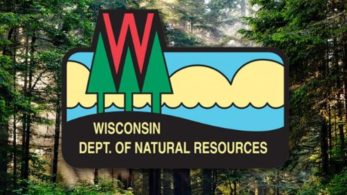Hunters and local businesses increase chronic wasting disease surveillance efforts in the north during the 2018 deer season
Contact(s): Janet Brehm, Wildlife Biologist for Lincoln and Langlade counties, 715-409-3277; Jeremy Holtz, Wildlife Biologist for Oneida County, 715-365-8999
MERRILL, Wis. – About 1,500 deer were sampled and tested for chronic wasting disease in Lincoln, Langlade, Oneida, Forest and Vilas counties during the 2018 CWD surveillance year (Apr. 1, 2018 – Mar. 31, 2019). The Department of Natural Resources encouraged hunters to submit tissue samples from harvested adult deer in two surveillance areas near Rhinelander.
These targeted CWD surveillance efforts occurred in northeastern Lincoln, northwestern Langlade and southern Oneida counties following the detection of CWD in two wild deer along the Lincoln/Oneida County border. The first of these cases was detected in January 2018 and the second in April 2018. Surveillance efforts also included eastern Oneida, southern Vilas and western Forest counties as a result of CWD positive deer found on an Oneida County captive deer hunting ranch in 2015.
“Numerous hunters submitted deer heads for testing from these areas and beyond. We are very thankful to the hunters and cooperating private businesses that stepped up to help with this important sampling effort. With their assistance, we are better able to understand the geographic distribution and prevalence of the disease,” said Janet Brehm, DNR wildlife biologist. “We couldn’t have done this without them.”
In addition to samples submitted from hunter harvested deer, this year the DNR offered free CWD surveillance permits to private landowners as well as to the public on select parcels of public land within these targeted surveillance areas. These permits were used to enhance CWD surveillance, and it was a requirement for all adult deer harvested under these permits to be CWD tested. The DNR had a projected sample goal of testing 450 deer from each area; the use of surveillance permits by hunters assisted greatly, accounting for about 25% of the total samples submitted.
Lincoln/Oneida county surveillance area
In the 2017 and 2018 deer seasons combined, about 430 deer were submitted and tested for CWD.
- A new CWD-positive wild deer was detected through the enhanced surveillance efforts in 2018. The sample was submitted voluntarily by a hunter during opening weekend of the gun deer season. This adult doe was harvested in south-central Oneida County in the town of Crescent, about 1.5 miles from the first wild CWD positive in Oneida and about 1.5 miles from the first wild positive in Lincoln County (town of Harrison).
- In total, the three known wild positives are clustered in close proximity, along the Lincoln/Oneida County line.
Oneida County surveillance area
- In the 2017 and 2018 deer seasons combined, 220 deer were submitted and tested for CWD.
- No wild deer have tested positive for CWD.
Baiting and Feeding
As required by law, the CWD positive detection in the fall of 2018 in south-central Oneida County renewed the existing three-year baiting and feeding ban in Oneida County and the two-year baiting and feeding ban for Langlade County. Lincoln County is still within the three-year baiting and feeding ban from the first CWD positive detection. Vilas and Forest counties still have baiting and feeding bans due to captive deer farm CWD positives.
“This additional positive CWD detection gives us a better understanding of where the disease is on the landscape and its prevalence in the local deer herd. During the 2019 deer season, hunters will again be encouraged to submit their adult deer for CWD sampling as we continue efforts in both surveillance areas, as well as throughout northern Wisconsin,” said Brehm. “We also plan to offer hunters surveillance permits again to help with continued disease assessment in the two surveillance areas.”
The DNR will continue to take the following steps:
- Work with County Deer Advisory Council members from the counties impacted by these CWD positive detections.
- Perform surveillance activities to assess disease distribution and prevalence including:
- Encourage reporting of sick deer
- Sample vehicle-killed adult deer
- Sample adult deer harvested under agricultural damage permits
- Sample adult deer harvested under urban deer hunts in the area
- Establish CWD sampling locations to be available during the 2019 deer hunting season.
Prevent the spread of CWD
There are recommended practices to reduce and prevent the spread of CWD that hunters, landowners, and any individual can assist with. Some of these actions include proper transportation, handling, and disposal of deer carcass waste, reporting sick deer, following baiting and feeding information, cleaning/decontamination of equipment, and following urine-based scent recommendations.
For more information regarding baiting and feeding regulations, ways to reduce the spread of CWD, and overall CWD information in Wisconsin, visit the DNR’s website, dnr.wi.gov, and search “bait and feeding” and “CWD” respectively. To report a sick deer on the landscape, search keywords “sick deer” or contact a local wildlife biologist.
You may also like
-
Pennsylvania Governor Josh Shapiro Signs Legislation Repealing Sunday Hunting Ban
-
Preserve Wisconsin’s legacy: Renew the Knowles-Nelson Stewardship Program | Opinion
-
Bringing New Hunters Afield: Inside NDA’s First Field to Fork Rifle Event on a Refuge
-
Minnesota Bill to Legalize Eating Beaver
-
BIGGER BUCKS OUTFITTERS has a deal for you!
